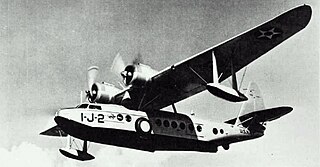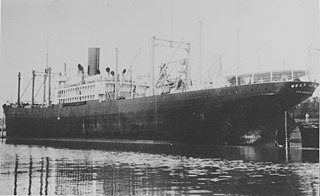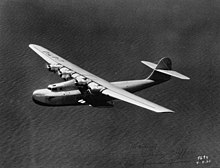
China Clipper (NC14716) was the first of three Martin M-130 four-engine flying boats built for Pan American Airways and was used to inaugurate the first commercial transpacific airmail service from San Francisco to Manila on November 22, 1935. Built at a cost of $417,000 by the Glenn L. Martin Company in Baltimore, Maryland, it was delivered to Pan Am on October 9, 1935. It was one of the largest airplanes of its time.
This is a list of aviation-related events from 1938:
This is a list of aviation-related events from 1935:
This is a list of aviation-related events from 1947:

Edwin Charles Musick was chief pilot for Pan American World Airways and pioneered many of Pan Am's transoceanic routes including the famous route across the Pacific Ocean, ultimately reaching the Philippine Islands, on the China Clipper.

Samoan Clipper was one of ten Pan American Airways Sikorsky S-42 flying boats. It exploded near Pago Pago, American Samoa, on January 11, 1938, while piloted by aviator Ed Musick. Musick and his crew of six died in the crash. The aircraft was carrying only airmail and express freight; no passengers were aboard.

The Sikorsky S-42 was a commercial flying boat designed and built by Sikorsky Aircraft to meet requirements for a long-range flying boat laid out by Pan American World Airways in 1931. The innovative design included wing flaps, variable-pitch propellers, and a tail-carrying full-length hull. The prototype first flew on 29 March 1934, and, in the period of development and test flying that followed, quickly established ten world records for payload-to-height. The "Flying Clipper" and the "Pan Am Clipper" were other names for the S-42.

The Martin PBM Mariner was a twin-engine American patrol bomber flying boat of World War II and the early Cold War era. It was designed to complement the Consolidated PBY Catalina and PB2Y Coronado in service. A total of 1,366 PBMs were built, with the first example flying on February 18, 1939, and the type entering service in September 1940, with the last of the type being retired in 1964.

The Martin JRM Mars is a large, four-engined cargo transport flying boat designed and built by the Martin Company for the United States Navy during World War II. It was the largest Allied flying boat to enter production, although only seven were built. The United States Navy contracted the development of the XPB2M-1 Mars in 1938 as a long-range ocean patrol flying boat, which later entered production as the JRM Mars long-range transport.

Flying Tiger Line Flight 739 (FT739/FTL739) was a Lockheed L-1049 Super Constellation propliner that disappeared on March 16, 1962, over the western Pacific Ocean. The aircraft, which had been chartered by the United States Army, was transporting ninety-six military passengers from Travis Air Force Base in California to Tan Son Nhut International Airport in Saigon, South Vietnam. After refueling at Andersen Air Force Base in Guam, the Super Constellation disappeared while en route to Clark Air Base in the Philippines. All 107 aboard were declared missing and presumed dead.

The Sikorsky S-43 is a 1930s American twin-engine amphibious flying boat monoplane produced by Sikorsky Aircraft.

The Martin 156, referred to in the press variously as the "Russian Clipper", "Moscow Clipper", or "Soviet Clipper" was a very large flying boat aircraft intended for trans-Pacific service. The single example of the M-156 was designed and built in response to a request from Pan American World Airways to provide a longer-range replacement for the Martin M-130.

The USAT Meigs was a United States Army transport ship that was built in 1921 and sunk in Darwin Harbour in the first Japanese air raid against the Australia mainland on 19 February 1942.

The Martin M-130 was a commercial flying boat designed and built in 1935 by the Glenn L. Martin Company in Baltimore, Maryland, for Pan American Airways. Three were built: the China Clipper, the Philippine Clipper and the Hawaii Clipper. All three had crashed by 1945. A similar flying boat design called the Martin 156) and named Russian Clipper, was built for the Soviet Union; it had a larger wing and twin vertical stabilizers.

Wake Island Airfield is a military air base located on Wake Island, which is known for the Battle of Wake Island during World War II. It is owned by the U.S. Air Force and operated by the 611th Air Support Group. The runway can be used for emergency landings by commercial jetliners flying transpacific routes and has been used in the past by airlines operating jet, turboprop, and prop aircraft on scheduled flights.
Transocean Air Lines was an airline based in the United States that operated from 1946, when it was established as ONAT (Orvis Nelson Air Transport Company), until its bankruptcy in 1960. It was based in Oakland, California.
Pan Am Flight 1104, trip no. 62100, was a Martin M-130 flying boat nicknamed the Philippine Clipper that crashed on the morning of January 21, 1943, in Northern California. The aircraft was operated by Pan American Airways and was carrying ten US Navy personnel from Pearl Harbor, Hawaii, to San Francisco, California. The aircraft crashed in poor weather into mountainous terrain about 7 mi (11 km) southwest of Ukiah, California.

The China Clipper flight departure site is listed as California Historical Landmark number 968. It is the site from which Pan American World Airways initiated trans-Pacific airmail service on November 22, 1935. A flying boat named China Clipper made the first trip, and the publicity for that flight caused all flying boats on that air route to become popularly known as China Clippers. For a few years, this pioneering mail service captured the public imagination like the earlier Pony Express, and offered fast luxury travel like the later Concorde.

Honolulu Clipper was the prototype Boeing 314 flying boat designed for Pan American Airways. It entered service in 1939 flying trans-Pacific routes.














